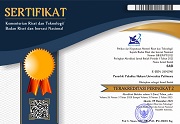The Law Protection for the Woman Victim of Violence on Traditional Marriage
 )
)
(1) Faculty of Law Pattimura University, Ambon, Indonesia
 Corresponding Author
Corresponding Author
Abstract
Introduction: The law regulation about the elimination of domestic violence has been regulated on dalam Law Number 23 of 2004 about The Elimination of Domestic Violence that, “to prevent, protect the victim, and take action to the domestic violence perpetrator, country, and society must do the prevention, protection, and the perpetrator prosecution that suitable with the Pancasila’s philosophy and the 1945 Constitution of the Republic of Indonesia”.
Purposes of the Research: The victim who is bound by marriage that has been done traditionally but not done civilly.
Methods of the Research: The research’s method on this writing is using the normative research’s method. A research’s method that been done with researching the library materials towards the regulations and literatures that relate with the problem that be researched. The Data that used is the secondary data with the secondary and tertiary legal materials collection priority. Then the data that be obtained are processed and served descriptively-analysis.
Results of the Research: The research’s results shows that the domestic violence that be experienced by the women who her marriage has been done traditionally based on the Law of The Elimination of Domestic Violence can be categorized as the Domestic Violence Criminal Act, but on the handling, the investigator keep to do the things that be mandated by the constitution by giving the victim’s rights and the law protection. The marriage’s status that been done traditionally doesn’t have the fixed legal foundation. But, the country keep guarantee the traditional existence in Indonesia.
Keywords
DOI
10.47268/sasi.v28i1.756
Published
2022-03-31
How To Cite
@article{SASI756,
author = {Hadibah Wadjo},
title = {The Law Protection for the Woman Victim of Violence on Traditional Marriage},
journal = {SASI},
volume = {28},
number = {1},
year = {2022},
keywords = {Law Protection; Law, Domestic Violence; Traditional Marriage},
abstract = {Introduction: The law regulation about the elimination of domestic violence has been regulated on dalam Law Number 23 of 2004 about The Elimination of Domestic Violence that, “to prevent, protect the victim, and take action to the domestic violence perpetrator, country, and society must do the prevention, protection, and the perpetrator prosecution that suitable with the Pancasila’s philosophy and the 1945 Constitution of the Republic of Indonesia”.Purposes of the Research: The victim who is bound by marriage that has been done traditionally but not done civilly.Methods of the Research: The research’s method on this writing is using the normative research’s method. A research’s method that been done with researching the library materials towards the regulations and literatures that relate with the problem that be researched. The Data that used is the secondary data with the secondary and tertiary legal materials collection priority. Then the data that be obtained are processed and served descriptively-analysis.Results of the Research: The research’s results shows that the domestic violence that be experienced by the women who her marriage has been done traditionally based on the Law of The Elimination of Domestic Violence can be categorized as the Domestic Violence Criminal Act, but on the handling, the investigator keep to do the things that be mandated by the constitution by giving the victim’s rights and the law protection. The marriage’s status that been done traditionally doesn’t have the fixed legal foundation. But, the country keep guarantee the traditional existence in Indonesia.},
issn = {2614-2961}, pages = {68--77} doi = {10.47268/sasi.v28i1.756},
url = {https://fhukum.unpatti.ac.id/jurnal/sasi/article/view/756}
}
Journal Article
Abdurrachman, Hamidah. "Perlindungan Hukum Terhadap Korban Kekerasan Dalam Rumah Tangga Dalam Putusan Pengadilan Negeri Sebagai Implementasi Hak-Hak Korban." Jurnal Hukum Ius Quia Iustum 17, no. 3 (2010). https://doi.org/10.20885/iustum.vol17.iss3.art7.
https://doi.org/10.20885/iustum.vol17.iss3.art7
Álvarez, Oscar Fernández, and Lally Kouadio Alexis. "Violence against Women and Children. A Distant and Domestic Hell." Procedia - Social and Behavioral Sciences 161 (2014). https://doi.org/10.1016/j.sbspro.2014.12.002.
https://doi.org/10.1016/j.sbspro.2014.12.002
Andang Sari, and Anggreany Haryani Putri. "Perlindungan Hukum Terhadap Perempuan Korban Kekerasan Dalam Rumah Tangga." Krtha Bhayangkara 14, no. 2 (2020). https://doi.org/10.31599/krtha.v14i2.291.
https://doi.org/10.31599/krtha.v14i2.291
Aziz, Abdul. "Islam Dan Kekerasan Dalam Rumah Tangga." Kordinat XVI, no. 1 (2017).
https://doi.org/10.15408/kordinat.v16i1.6460
Fazraningtyas, Winda Ayu, Dini Rahmayani, and Indana Rahmah Fitriani. "Kejadian Kekerasan Pada Perempuan Selama Masa Pandemi COVID-19." Dinamika Kesehatan: Jurnal Kebidanan Dan Keperawatan 11, no. 1 (2020). https://doi.org/10.33859/dksm.v11i1.550.
https://doi.org/10.33859/dksm.v11i1.550
Rofiah, Nur. "Kekerasan Dalam Rumah Tangga Dalam Perspektif Islam." Wawasan: Jurnal Ilmiah Agama Dan Sosial Budaya 2, no. 1 (2017). https://doi.org/10.15575/jw.v2i1.829.
https://doi.org/10.15575/jw.v2i1.829
Setyaningrum, Ayu, and Ridwan Arifin. "Analisis Upaya Perlindungan Dan Pemulihan Terhadap Korban Kekerasan Dalam Rumah Tangga (KDRT) Khususnya Anak-Anak Dan Perempuan." JURNAL MUQODDIMAH : Jurnal Ilmu Sosial, Politik Dan Hummaniora 3, no. 1 (2019). https://doi.org/10.31604/jim.v3i1.2019.9-19.
https://doi.org/10.31604/jim.v3i1.2019.9-19
Susanto, Anthon Freddy. "Pendekatan Restoratif Dalam Kekerasan Rumah Tangga Menurut Perspektif Hukum Pidana." Pagaruyuang Law Journal 4, no. 2 (2021).
https://doi.org/10.31869/plj.v4i2.2470
Book
Fakih, Mansour. Analisis Gender Dan Transformasi Sosial. Yogyakarta: Pustaka Pelajar, 2010.
Hadikusuma, Hilman. Hukum Perkawinan Adat Dengan Adat Istiadat Dan Upacara Adatnya. Bandung: Citra Aditya, 2003.
Imam, Ahmad. Perempuan Dalam Kebudayaan. Yogyakarta: PT. Tiara Wacana, n.d.
Saraswati, Rika. Perempuan Dan Penyelesaian Kekerasan Dalam Rumah Tangga. Bandung: Citra Aditya Bakti, 2006.
Soekanto, Soerjono, and Sri Mamudji. "Penelitian Normatif (Suatu Tinjauan)." Jakarta: Rajawali Press, 2001.
Soetoprawiro, Koerniatmanto, Ratna Riyanti, and Soesi Idayanti. "Upaya Perlindungan Hukum Terhadap Korban Kekerasan Dalam Rumah Tangga." Bandung, 2012.
| Dublin Core | PKP Metadata Items | Metadata for this Document | |
| 1. | Title | Title of document | The Law Protection for the Woman Victim of Violence on Traditional Marriage |
| 2. | Creator | Author's name, affiliation, country | Hadibah Zachra Wadjo; Faculty of Law Pattimura University, Ambon; Indonesia |
| 3. | Subject | Discipline(s) | |
| 3. | Subject | Keyword(s) | Law Protection; Law, Domestic Violence; Traditional Marriage |
| 4. | Description | Abstract | Introduction: The law regulation about the elimination of domestic violence has been regulated on dalam Law Number 23 of 2004 about The Elimination of Domestic Violence that, “to prevent, protect the victim, and take action to the domestic violence perpetrator, country, and society must do the prevention, protection, and the perpetrator prosecution that suitable with the Pancasila’s philosophy and the 1945 Constitution of the Republic of Indonesia”.Purposes of the Research: The victim who is bound by marriage that has been done traditionally but not done civilly.Methods of the Research: The research’s method on this writing is using the normative research’s method. A research’s method that been done with researching the library materials towards the regulations and literatures that relate with the problem that be researched. The Data that used is the secondary data with the secondary and tertiary legal materials collection priority. Then the data that be obtained are processed and served descriptively-analysis.Results of the Research: The research’s results shows that the domestic violence that be experienced by the women who her marriage has been done traditionally based on the Law of The Elimination of Domestic Violence can be categorized as the Domestic Violence Criminal Act, but on the handling, the investigator keep to do the things that be mandated by the constitution by giving the victim’s rights and the law protection. The marriage’s status that been done traditionally doesn’t have the fixed legal foundation. But, the country keep guarantee the traditional existence in Indonesia. |
| 5. | Publisher | Organizing agency, location | Faculty of Law, Universitas Pattimura |
| 6. | Contributor | Sponsor(s) | |
| 7. | Date | (YYYY-MM-DD) | 2022-03-31 |
| 8. | Type | Status & genre | Peer-reviewed Article |
| 8. | Type | Type | |
| 9. | Format | File format | |
| 10. | Identifier | Uniform Resource Identifier | https://fhukum.unpatti.ac.id/jurnal/sasi/article/view/756 |
| 10. | Identifier | Digital Object Identifier | 10.47268/sasi.v28i1.756 |
| 11. | Source | Title; vol., no. (year) | SASI; Volume 28 Issue 1, March 2022 |
| 12. | Language | English=en | en |
| 13. | Relation | Supp. Files | |
| 14. | Coverage | Geo-spatial location, chronological period, research sample (gender, age, etc.) | |
| 15. | Rights | Copyright and permissions | Copyright: Authors who publish their manuscripts in this Journal agree to the following conditions: 1. The copyright in each article belongs to the author, as well as the right to patent. 2. Authors can enter into separate, additional contractual arrangements for the non-exclusive distribution of the journal's published version of the work (e.g., post it to an institutional repository or publish it in a book), with an acknowledgment of its initial publication in this journal. 3. Authors are permitted and encouraged to post their work online (e.g., in institutional repositories or on their website) before and during the submission process, as it can lead to productive exchanges, as well as earlier and greater citation of published work. 4. Authors have the right to self-archiving of the article (Author Self-Archiving Policy)
License: The SASI Journal is disseminated based on the Creative Commons Attribution-NonCommercial 4.0 International license terms. This license allows anyone to copy and redistribute this material in any form or format, compose, modify, and make derivatives of this material for any purpose. You cannot use this material for commercial purposes. You must specify an appropriate name, include a link to the license, and certify that any changes have been made. You can do this in a way that is appropriate but does not imply that the licensor supports you or your use.
|
Copyright (c) 2022 Hadibah Zachra Wadjo

This work is licensed under a Creative Commons Attribution-NonCommercial 4.0 International License.

 : 2080 times
: 2080 times Download : 989 times
Download : 989 times
















